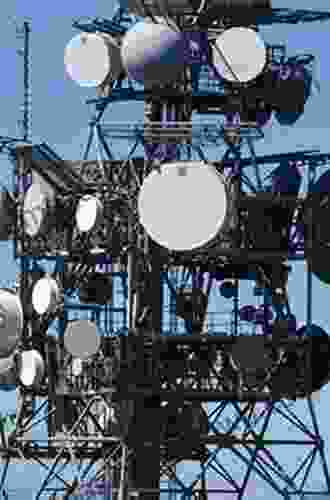Optical and Microwave Technologies for Telecommunication Networks: The Comprehensive Guide

4 out of 5
| Language | : | English |
| File size | : | 20509 KB |
| Text-to-Speech | : | Enabled |
| Screen Reader | : | Supported |
| Enhanced typesetting | : | Enabled |
| Word Wise | : | Enabled |
| Print length | : | 478 pages |
| Lending | : | Enabled |
Optical and Microwave Technologies for Telecommunication Networks is a comprehensive guide to the latest technologies used in telecommunications networks. The book covers a wide range of topics, from the basics of optical fiber to the latest advances in microwave technology. It is an essential resource for anyone working in the field of telecommunications.
Optical Fiber
Optical fiber is a thin, flexible strand of glass or plastic that is used to transmit light signals over long distances. Optical fiber is used in a wide range of applications, including telecommunications, data networks, and medical imaging. The basic principles of optical fiber are relatively simple. Light is transmitted through the fiber by means of total internal reflection. This means that the light is trapped inside the fiber and cannot escape, even if the fiber is bent or twisted.
There are many different types of optical fiber, each with its own unique properties. The most common type of optical fiber is single-mode fiber. Single-mode fiber has a small core, which allows only one mode of light to propagate through the fiber. This makes single-mode fiber ideal for long-distance applications, as it reduces the amount of signal loss. Multi-mode fiber has a larger core, which allows multiple modes of light to propagate through the fiber. This makes multi-mode fiber more suitable for short-distance applications, such as data networks.
Microwave Technology
Microwave technology is used to transmit radio waves in the microwave frequency range. Microwave frequencies are typically between 300 MHz and 300 GHz. Microwave technology is used in a wide range of applications, including telecommunications, radar, and navigation. The basic principles of microwave technology are relatively simple. Microwave signals are transmitted through the air by means of electromagnetic waves. These waves are generated by an antenna, and they travel in a straight line until they encounter an object. When the waves encounter an object, they are reflected back to the antenna. The antenna then converts the reflected waves into an electrical signal, which can be processed by a receiver.
There are many different types of microwave technology, each with its own unique properties. The most common type of microwave technology is line-of-sight microwave technology. Line-of-sight microwave technology requires a clear line of sight between the transmitter and the receiver. This type of technology is used in a wide range of applications, including telecommunications, radar, and navigation. Non-line-of-sight microwave technology does not require a clear line of sight between the transmitter and the receiver. This type of technology is used in a wide range of applications, including cellular networks and satellite communications.
Applications of Optical and Microwave Technologies in Telecommunication Networks
Optical and microwave technologies are used in a wide range of applications in telecommunication networks. Some of the most common applications include:
- Telecommunications: Optical and microwave technologies are used to transmit voice, data, and video signals over long distances. This is the most common application of optical and microwave technologies, and it is used by a wide range of businesses and consumers.
- Data networks: Optical and microwave technologies are used to create high-speed data networks. These networks are used by businesses and organizations to connect their computers and other devices. Optical and microwave technologies can also be used to create wireless data networks, which allow users to access the internet and other data services without the need for a physical connection.
- Medical imaging: Optical and microwave technologies are used in a wide range of medical imaging applications. These applications include X-rays, MRI scans, and ultrasound scans. Optical and microwave technologies can also be used to create medical devices, such as lasers and endoscopes.
Optical and microwave technologies areEssential technologies for telecommunication networks. These technologies are used in a wide range of applications, from telecommunications to data networks to medical imaging. The book Optical and Microwave Technologies for Telecommunication Networks is a comprehensive guide to these technologies. It is an essential resource for anyone working in the field of telecommunications.
4 out of 5
| Language | : | English |
| File size | : | 20509 KB |
| Text-to-Speech | : | Enabled |
| Screen Reader | : | Supported |
| Enhanced typesetting | : | Enabled |
| Word Wise | : | Enabled |
| Print length | : | 478 pages |
| Lending | : | Enabled |
Do you want to contribute by writing guest posts on this blog?
Please contact us and send us a resume of previous articles that you have written.
 Book
Book Novel
Novel Page
Page Chapter
Chapter Text
Text Story
Story Genre
Genre Reader
Reader Library
Library Paperback
Paperback E-book
E-book Magazine
Magazine Newspaper
Newspaper Paragraph
Paragraph Sentence
Sentence Bookmark
Bookmark Shelf
Shelf Glossary
Glossary Bibliography
Bibliography Foreword
Foreword Preface
Preface Synopsis
Synopsis Annotation
Annotation Footnote
Footnote Manuscript
Manuscript Scroll
Scroll Codex
Codex Tome
Tome Bestseller
Bestseller Classics
Classics Library card
Library card Narrative
Narrative Biography
Biography Autobiography
Autobiography Memoir
Memoir Reference
Reference Encyclopedia
Encyclopedia Shannon Kennedy
Shannon Kennedy Lavie Margolin
Lavie Margolin Sarah Elisabeth Sawyer
Sarah Elisabeth Sawyer Lukasz Laniecki
Lukasz Laniecki Simple Language Learning
Simple Language Learning William Patten
William Patten John Gillham
John Gillham Rajan Suri
Rajan Suri Justin Carrier
Justin Carrier Robin Landa
Robin Landa Marco Benedet
Marco Benedet Joann Ross
Joann Ross John H Martin
John H Martin R T Fitch
R T Fitch John Aston
John Aston Ladee Hubbard
Ladee Hubbard Joanne Fisher
Joanne Fisher Susan Broesche
Susan Broesche Steven Posusta
Steven Posusta Jim Maccracken
Jim Maccracken
Light bulbAdvertise smarter! Our strategic ad space ensures maximum exposure. Reserve your spot today!

 Norman ButlerIncidents of Travel in Greece, Turkey, Russia, and Poland: A Journey into the...
Norman ButlerIncidents of Travel in Greece, Turkey, Russia, and Poland: A Journey into the...
 Xavier BellDaughter of Jerusalem: A Literary Masterpiece Exploring the Power of Hope and...
Xavier BellDaughter of Jerusalem: A Literary Masterpiece Exploring the Power of Hope and... Douglas PowellFollow ·18.2k
Douglas PowellFollow ·18.2k Jaylen MitchellFollow ·14.3k
Jaylen MitchellFollow ·14.3k Guy PowellFollow ·16.8k
Guy PowellFollow ·16.8k Zachary CoxFollow ·5.6k
Zachary CoxFollow ·5.6k Stan WardFollow ·3.1k
Stan WardFollow ·3.1k Derrick HughesFollow ·17.7k
Derrick HughesFollow ·17.7k Ross NelsonFollow ·11.5k
Ross NelsonFollow ·11.5k Jared NelsonFollow ·9.5k
Jared NelsonFollow ·9.5k

 Joshua Reed
Joshua ReedTake Your Marketing Business Into The Next Level
Are you ready to...

 Aaron Brooks
Aaron BrooksFrom Fourier to Cauchy-Riemann: Geometry Cornerstones
From Fourier to Cauchy-Riemann: Geometry...

 Orson Scott Card
Orson Scott CardUnveiling the Art of Mitigation Banking: A Comprehensive...
In the intricate dance between...

 Victor Hugo
Victor HugoUnleash Your Creativity: A Journey Through the Enchanting...
Prepare to be captivated as we...

 Duncan Cox
Duncan CoxLoad of Bull: An Englishman's Adventures in Madrid
By Simon Bunce ...
4 out of 5
| Language | : | English |
| File size | : | 20509 KB |
| Text-to-Speech | : | Enabled |
| Screen Reader | : | Supported |
| Enhanced typesetting | : | Enabled |
| Word Wise | : | Enabled |
| Print length | : | 478 pages |
| Lending | : | Enabled |










